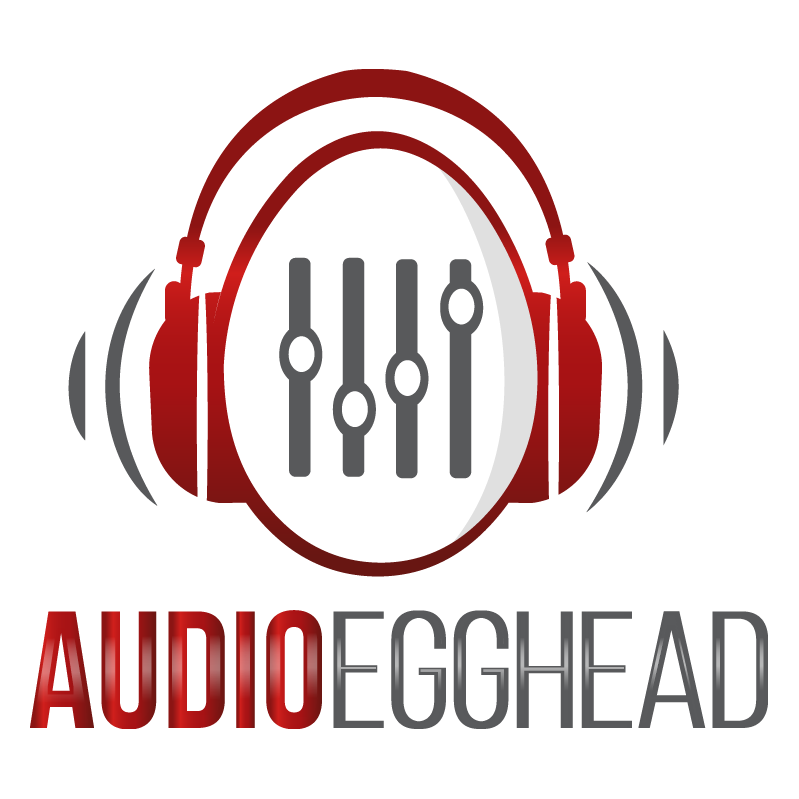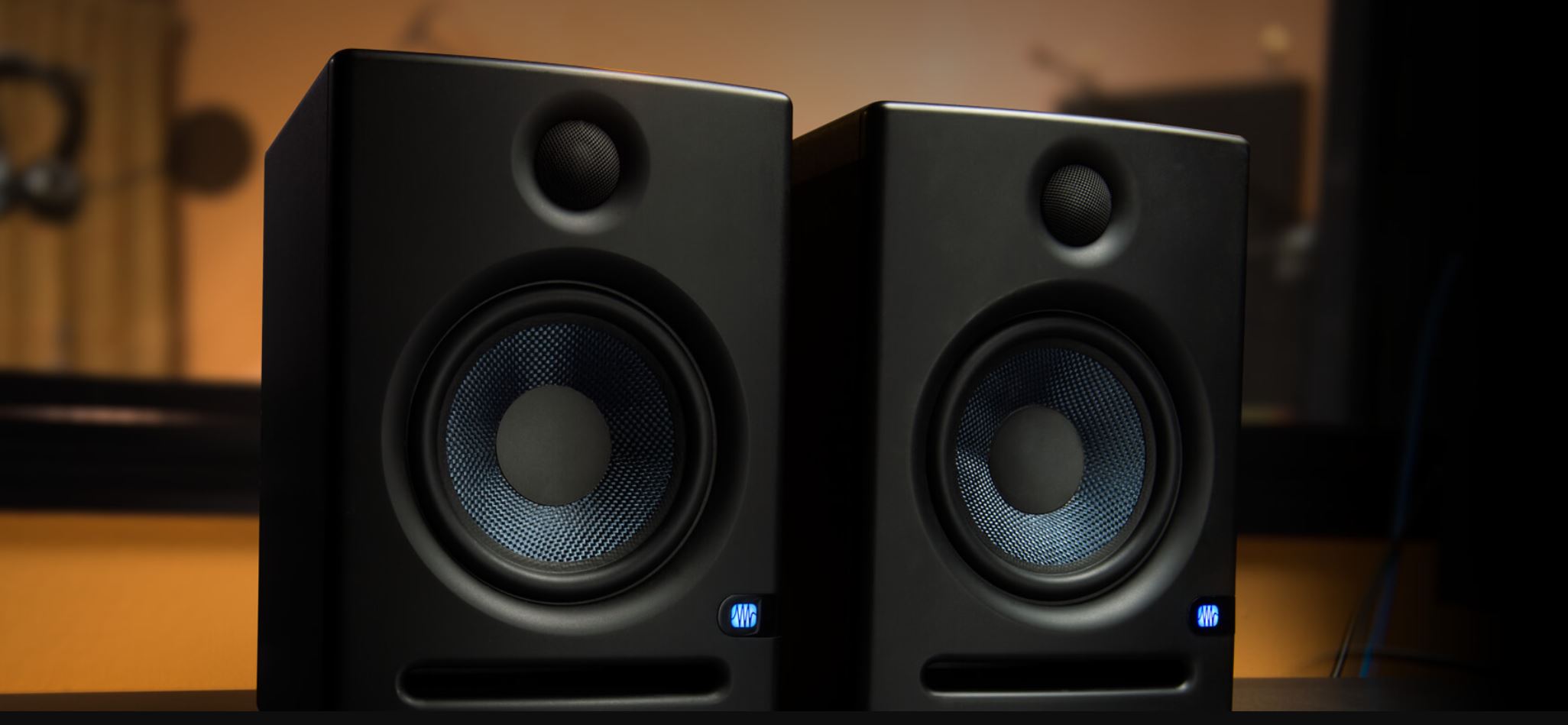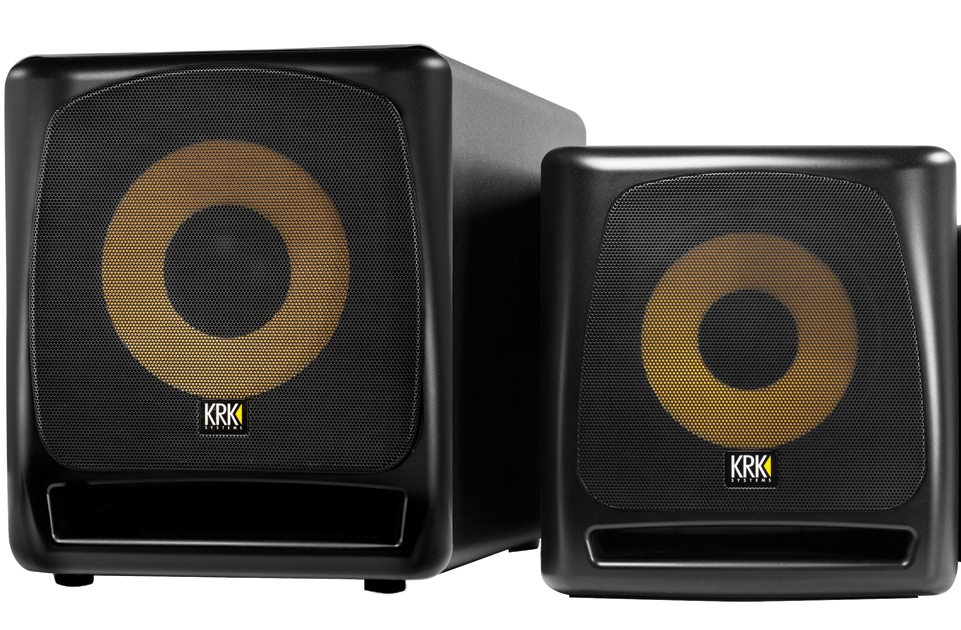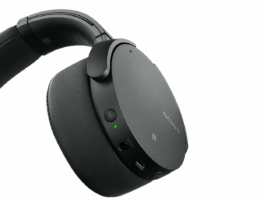Whether you’re building a recording studio, or just getting into music production, all true audiophiles need a good set of studio monitors. Whether you aspire to create your own music studio, or you just want to blast some pure quality music the way the recording artists intended, you need a great set of monitors. If you are creating a mixing studio on a budget, you are indeed looking to find the best quality monitors at the most economical price. In this survey, we attempted to find the best studio monitors under 500 dollars.
It goes without saying that you are welcome to spend as much money as you want on music equipment––but the $500 price range represents a sweet spot: a perfect intersection of price and performance.
In a Hurry? Here’s Our Verdict
The Best Single Monitor Under $500:
- KRK Rokit Powered 10-3 Pair Mid-Field 3-Way Powered Studio Monitor
- Note that the above link is for ONE monitor. Be sure to order 2!
The Best PAIR of Monitors Just Barely Over $500 (Total):
- PreSonus Eris E8 8-Inch 2-Way Monitors
- Note that the above link is for ONE monitor. Be sure to order 2!
Frequently Asked Questions
The intricacies of audio engineering take a lifetime to master, and experience is your best teacher. Purchasing the best studio monitors under 500 dollars will set you up with sufficient quality equipment to get a professional sounding mix.
1. What Is A Studio Monitor And How Is It Different From A Speaker?
Studio monitors are different from your average bookcase speakers in that they are built to create a “flat” frequency playback sound––matching the exact frequencies sent to them, with no added bass, mid-range, etc. They are sometimes also known as “reference monitors” because they can be used as a reference point for mixing and mastering.
Most consumer-driven commercial speakers, however, are built in such a way that they alter the original sound somewhat. They distort the music just enough that it sounds different, often in a way that will give a punchy sound to pop music. This is a way of making the speakers sound more crisp and appealing on a sales floor, and it certainly makes sense if your goal is to sell as many speakers as possible.
However, it is not what professional musicians typically want in their studios. These consumer speakers mask the true balance of the original track. If you’re editing rather than listening, and you’re trying to create a great mix, you want something that prizes accuracy above all else.
This isn’t to say that consumer speakers are automatically bad. Many of them have fantastic build quality and are fun to listen to. They are simply built for one purpose: consuming music. Studio monitors, on the other hand, are designed for creating music (or for simply listening to an accurate version of the track).
Studio monitors are also engineered to fill rooms with a smaller volume. Monitors are the preferred tools used by audio engineers to isolate, manage, and mix music.
2. What Is Frequency Response?
The frequency response rating of a monitor represents the sound frequencies that a monitor can reproduce.
The general auditory frequency response range for human beings is 20Hz to 20kHz.
However, many high-quality speakers exceed this range. Sound is created by frequencies carried through air, and even if the frequency is outside of the auditory range, you can still feel the frequency, and it has a sensory effect on your listening experience.
There are videos on YouTube that provide examples of low and high frequencies to give you an idea of what frequency response range is best for your needs.
3. What Is Power Output?
When you’re considering what pair of studio monitors you should buy, you should pay attention to the power output levels. Power output is measured in watts, and it represents how loud a sound your monitor can produce.
Most of us want the option to crank up the noise and produce some loud volume from our monitors––but we don’t want to sacrifice the sound quality when things are loud (or quiet).
For music production, this is especially important. A good monitor will have the option to produce a deep bass sound, as well as delivering clarity on the upper and middle ranges.
While your speakers’ power levels are measured in watts, the actual sound level that they produce will be measured in decibels. It’s a good idea to look for studio monitors that can handle at least 100dB, and the best will get up closer to 110dB. This about twice as loud as a typical conversation, but still not as loud as an ambulance siren.
For the purpose of music production, it’s rarely the case that you’ll want to blast your music at maximum volume most of the time. For one thing, it just won’t be great for your ears. But it’s good to have the option every once in a while, just to get a sense of how your music will sound at different levels of loudness. And of course, you want to make sure that the sound quality continues even at louder levels.
4. How Can You Judge Sound Quality?
There are a few different components when it comes to your monitor’s sound quality.
First up, you want to find a monitor with a low “total harmonic distortion”, or THD for short. The THD is a measure of how much the speakers will distort or change the sound of the track during output. In this case, a lower number is better, because that means there’s actually less distortion going on. You should look for a THD under 0.08% if at all possible. The higher that number goes, the less faithfully the speakers are actually replicating that sound.
Another component is headroom. This term can be a bit confusing because it doesn’t actually have anything to do with a person’s head. Instead, it describes what the speaker can do with a sudden burst of sound. If you want to get a boost for a quick “punch” of sound, a higher headroom number is better.
Paying attention to both these numbers will help you pick the best studio monitor for your goals.
5. Can You Mix With Only One Monitor?
Technically, yes, you can… but you shouldn’t. There are a lot of reasons why two monitors are better than one, but the main difference comes down to hearing a track in stereo as opposed to mono.
Professional audio engineers use two speakers because it allows them to mix in stereo.
When you mix with one speaker, you are mixing in mono.
Mono means you only have one channel of sound. Stereo means you have two channels of sound. With stereo, you can give the listener the sensation that certain instruments are “coming from” certain directions.
Stereo allows you to pan things from left to right, creating a more multi-dimensional, spacious listening experience.
This directional aspect of music is a huge component of mixing and mastering. It create a fuller sound experience for the audience, and listeners have come to expect it as part of most contemporary music. While you can use just a single speaker or monitor, you will be missing out on a significant dimension of what the listeners will ultimately hear when they play the track on their own twin speaker systems. Even most headphones provide this spacial element, so it’s not something to overlook.
Plainly put: you won’t find music mixed in mono in the present-day. It’s much better to get two monitors.
And more importantly ensure you know whether you are buying one or two monitors (hint: they aren’t always sold in pairs).
6. Can You Just Mix With Headphones?
It might also be tempting to rely just on a pair of open-back reference headphones for mixing and mastering. There are some great ones out there, and I have reviewed some of my favorites in the past.
While I certainly think that reference headphones are a great tool to have in your arsenal, they shouldn’t be your only tool for listening to your music while you edit. They can’t and shouldn’t completely replace a pair of studio monitors. Monitors are simply capable of giving much more detailed and richer sound quality than you’ll find in most headphones.
It is a good exercise to experience mixing with both, if you haven’t already done that. This gives you a sense of the difference between the two.
If you want to pick up a pair of reference headphones in addition to studio monitors, you can check out that list. But if you have to go with just one piece of equipment, I’d say that a pair of stereo studio monitors are your best option for getting your ideal mix.
How We Reviewed The Monitors On This List
- Sound quality
- Accuracy
- Cabinet size
- Frequency response
- Power output
We gave our overall impression of sound quality and indications of durability and construction of the monitors. We concluded each of our surveys with a list of pros and cons regarding that monitor.
Overall Price Range Of The Following Suggestions
This list is for the best studio monitors under 500 dollars, but the pricing sometimes refers to two monitors and sometimes only refers to one.
When you make your final decision based on our list of the best studio monitors under 500 dollars, make sure that you are clear whether your purchase includes one or two monitors.
It’s worth noting that tore expensive monitors usually are larger with greater power output and higher frequency range.
What We Reviewed
- Yamaha HS8 Studio Monitor
- Edifier S2000pro Powered Bluetooth Bookshelf Speakers
- KRK ROKIT G4 8″ 2-Way Powered Studio Monitor
- KRK Rokit Powered 10-3 Pair Mid-Field 3-Way Powered Studio Monitors
- JBL Professional 305P Studio Monitors
- Focal Alpha 80 8″ Powered Studio Monitor
- PreSonus Eris E8 8-Inch 2-Way Active Studio Monitor
- Adam Audio F7 7″ Powered Studio Monitor
- Mackie XR824 Professional Studio Monitor
- M-Audio BX8 Carbon Studio Monitor
Yamaha HS8 Studio Monitor
Features
 This classic Yamaha studio monitor features the iconic white woofer emblematic of Yamaha speakers since the 70s. Note that the purchasing price for this speaker is only for one speaker, not a set.
This classic Yamaha studio monitor features the iconic white woofer emblematic of Yamaha speakers since the 70s. Note that the purchasing price for this speaker is only for one speaker, not a set.
The speaker features an 8-inch cone woofer and a 1-inch dome tweeter.
The monitor box is 14 X 16 X 21 inches and is compatible with wall, ceiling, and baton brackets.
The port system is an advanced design that allows the speaker to reduce the vortex while still creating very accurate bass reproductions.
The power output is 120W, and the frequency response is 38Hz to 30kHz.
Pros
- Accurate sound
- Technologically advanced port speaker
- Compact and easy to mount
Cons
- Some distortion has been reported at very high volumes
Price $$
Edifier S2000pro Powered Bluetooth Bookshelf Speakers
Features
 These are attractive, solid, and weighty speakers that come in a faux wood grain body.
These are attractive, solid, and weighty speakers that come in a faux wood grain body.
The purchasing price includes two speakers.
They measure 20 x 16.9 x 14.3 inches and weigh 21.7 pounds each.
The speakers feature flat diaphragm tweeters and 5.5-inch woofers. Sound quality is good overall, but these speakers lack the crisp clarity of other speakers in our survey.
The total power output is 124W.
The purchase price includes multiple connection cables.
It’s worth noting that these are also Bluetooth-compatible—so you can easily connect them to your mobile devices.
Pros
- Attractive
- Two speakers included in purchase price
- Bluetooth compatible
Cons
- Sound quality is not as good as its competitors
Price $
KRK ROKIT 8 G4 8″ 2-Way Powered Studio Monitor
Features
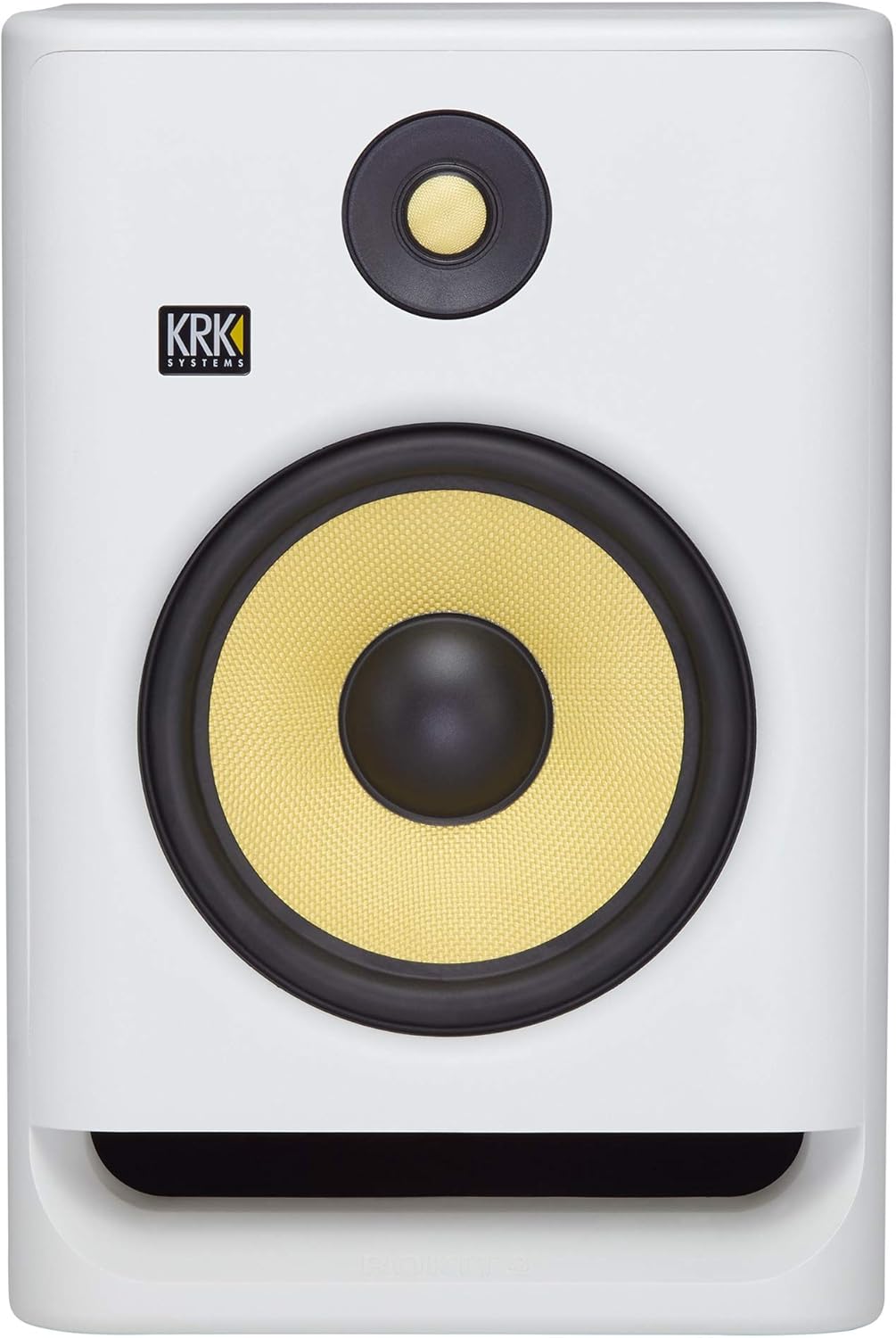 This is a stylish, compact speaker that includes an 8-inch, glass-aramid composite woofer, and a 1-inch soft dome tweeter.
This is a stylish, compact speaker that includes an 8-inch, glass-aramid composite woofer, and a 1-inch soft dome tweeter.
The unit measures 11.73 x 10.83 x 15.50 inches and weighs 26.5 pounds.
Note that the purchase price is for a single monitor.
Power output is 100W, and the frequency response is 35Hz to 35KHz.
These are great speakers that offer plenty of power and reproduce a crisp and accurate sound. Consider adding the KRK 10s 10″ powered subwoofer to fill in some of that missing low-end.
Pros
- Great monitor for mixing
- Accurate sound
- Compact and durable design
Cons
- Does not include cables
- 35Hz isn’t the lowest bass frequency in the market
Price $
KRK ROKIT Powered 10-3 Pair Mid-Field 3-Way Powered Studio Monitors
Features
 These things don’t mess around. Great for the serious music producer. This is a very large monitor that measures 21.5 x 12.8 x 14.4 inches.Each speaker weighs 46 pounds.
These things don’t mess around. Great for the serious music producer. This is a very large monitor that measures 21.5 x 12.8 x 14.4 inches.Each speaker weighs 46 pounds.
The power output is 140W, and the frequency response is 31Hz – 30KHz.
The speaker features a 1-inch soft-dome tweeter and a 10-inch glass-Aramid composite woofer. The speaker also has a 4-inch midrange driver that helps create a fuller, richer sound. These are great monitors that produce an accurate sound with a lot of power—ideal either for mixing or casual listening.
Pros
- Solid and durable
- Good frequency response
- Good monitor for mixing
Cons
- Large
- Heavy
Price $$$
JBL Professional 305P MKII Studio Monitors
Features
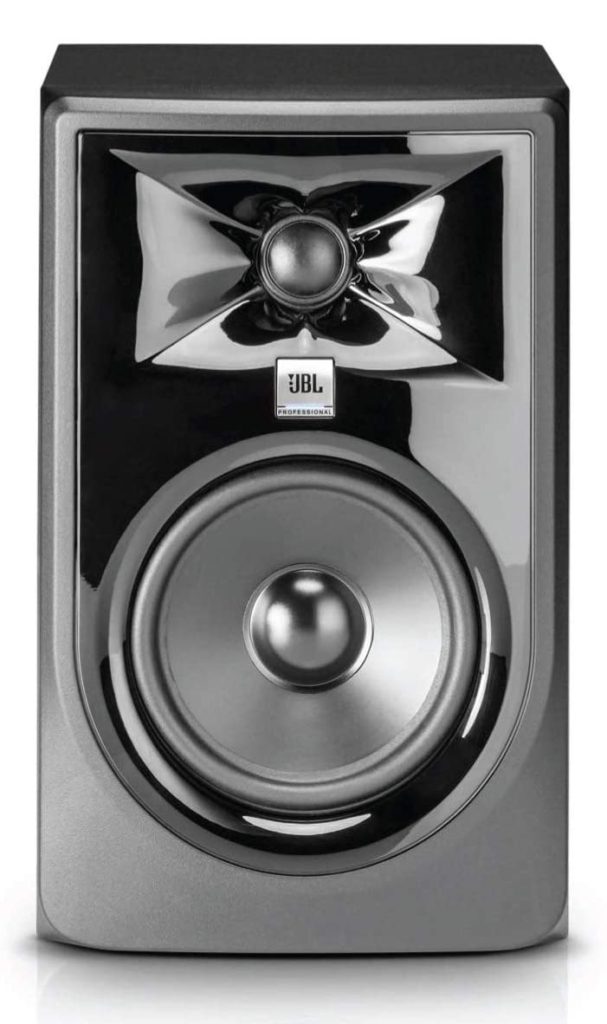 Replacing the first gen JBL LSR305, this is a compact and affordable speaker that creates a good sound at an economical price.
Replacing the first gen JBL LSR305, this is a compact and affordable speaker that creates a good sound at an economical price.
The speaker is 15 x 13 x 10 inches and weighs only 10.4 pounds.
The monitor features a 5-inch woofer and a 1-inch tweeter.
It has a power output of 41W, and its frequency response is 43 Hz-24kHz.
The smaller frequency response is because this is a smaller speaker that cannot move the same volume of air as a bigger speaker.
Sound accuracy is very good, and these speakers represent a great monitor to meet a limited budget.
Pros
- Affordable
- Compact
- Accurate sound replication
Cons
- Smaller frequency response range
- Low power
Price $
Focal Alpha 80 8″ Powered Studio Monitor
Features
 This is a durable and attractive, all-black studio monitor.
This is a durable and attractive, all-black studio monitor.
The unit measures 20 x 16.5 x 14 inches and weighs 20.7 pounds.
The frequency response is 40Hz to 22kHz, which is smaller than some other monitors on our list but still covers the auditory range of human beings. The 6.5-inch combination woofer/midrange speaker has a Polyglass cone in a laminar port.
Automatic standby mode turns the speaker off when they’ve been inactive for 30 minutes. Its power output of 140W gives you plenty of volume potential.
Pros
- Very good sound, particularly the bass
- Attractive design
- Compact and durable
Cons
- Smaller frequency response range
Price $$$
PreSonus Eris E8 8-Inch 2-Way Active Studio Monitor
Features
 This is another sleek-looking, all-black monitor set that disappears into the shadows and can fill the room with crystal clear, high-quality sound.
This is another sleek-looking, all-black monitor set that disappears into the shadows and can fill the room with crystal clear, high-quality sound.
The cabinet is vinyl-laminated, medium-density fiberboard, and measures 9.84 x 11.77 x 15.12 inches.
Each monitor weighs 22.2 pounds.
The speaker features an 8-inch woofer that has a sufficient volume of air movement to create a nice bass experience. The tweeter is a 1.25-inch silk dome.
Its frequency response is 35 Hz to 22kHz accompanied, with a power output of 140W.
This is a good quality, economical speaker set that comes in right around $500 for a pair.
Pros
- Price is for a set
- Comes with cables
- Big performance in a small package
Cons
- Smaller frequency response than some
Price $$
Adam Audio “F7 7” Powered Studio Monitor
Features
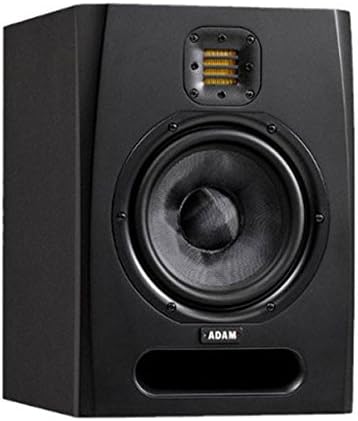 This compact port monitor is 9 x 12.5 x 10.5 inches and weighs 19.8 pounds.
This compact port monitor is 9 x 12.5 x 10.5 inches and weighs 19.8 pounds.
It features a 7-inch woofer and a 1.5-inch tweeter.
Its frequency response range is 44Hz to 50kHz, and its power output is 85W.
It comes equipped with XLR, RCA, and TRS input connectors.
Overall, this is a good sounding speaker, but the 7-inch woofer doesn’t quite match the low-end of the larger speakers.
Overall, we thought the price is a little high for the performance, but regardless, this is a good quality unit.
Pros
- Compact
- Good high-end frequency response
- Big performance in a small package
Cons
- Low-end could perform better
Price $$$
Mackie XR824 Professional Studio Monitor
Features
 The Mackie XR824 professional studio monitor is a good performing, but not very attractive monitor.
The Mackie XR824 professional studio monitor is a good performing, but not very attractive monitor.
The black wood grain finish cabinet measures 14.4 x 13.3 x 19.4 inches and weighs 22.2 pounds.
Its frequency response range is 36 Hz to 22 kHz, and the power output is 160W.
The speaker features an 8-inch Kevlar woofer and a 1-inch black anodized aluminum dome tweeter.
The speaker also features a low-frequency extension due to the speaker’s ELP bass reflex system.
This speaker performs better┬áin terms of clean, authentic sound than the speakers in the lower price range and is a great choice if your budget isn’t limited.
Pros
- Accurate sound reproduction
- Powerful
- Compact
Cons
- Less-attractive cabinet
- Price is for a single-unit
Price $$
M-Audio BX8 Carbon Studio Monitor
Features
 The M-Audio BX8 Carbon is an attractive, durable, and high-powered mixing monitor.
The M-Audio BX8 Carbon is an attractive, durable, and high-powered mixing monitor.
The 8-inch woofer features a Kevlar curved cone, and the 1.25-inch tweeter has a magnetically shielded natural silk dome.
Its frequency response is 38 Hz to 22 kHz.
The speaker measures 15 x 10 x 12 inches, and each speaker weighs 26.4 pounds.
This monitor has a power output of 130W.
These speakers are capable of matching the sound quality of much more expensive audio systems.
The M-Audio BX8 Carbon represents a sweet intersection point of price and quality.
Pros
- Inexpensive
- Good power output
- High volume 8 inch woofer
Cons
- High demand means low availability
- Heavy
Price $$
Which Are The Best Monitors For Under 500 Dollars? Our Verdict
Our Favorite PAIR of Monitors Under $500
 Our favorite PAIR of monitors under $500 was the PreSonus Eris E8 8-Inch 2-Way Active Studio Monitor.(Be sure to order 2, as they’re still usually sold individually)
Our favorite PAIR of monitors under $500 was the PreSonus Eris E8 8-Inch 2-Way Active Studio Monitor.(Be sure to order 2, as they’re still usually sold individually)
The PreSonus includes 2 monitors at the $500 price point which allows aspiring audio engineers to rock out in stereo from day one.
The M-Audio BX8 Carbon Studio Monitor is very similar to the PreSonus at the same price range, but the PreSonus provides more at the low end and has a higher power output.
Our Favorite SINGLE Monitor Under $500
 Our favorite SINGLE monitor under $500 is the KRK Rokit Powered 10-3 Mid-Field 3-Way Powered Studio Monitor.
Our favorite SINGLE monitor under $500 is the KRK Rokit Powered 10-3 Mid-Field 3-Way Powered Studio Monitor.
This monitor is the only monitor in our ‘best studio monitors under 500 dollars’ survey that includes a midrange driver.
One advantage with the midfield KRK Rockit 10-3 is that it’s larger than your average nearfield monitors, and the midrange driver helps it compensate for just having a single unit. The bass response is much better than that of the Rokit 8, Rokit 6 or Rokit 5.
Maybe you’ve got a budget studio or a small studio. Maybe the room acoustics of your studio aren’t ideal, or maybe there simply isn’t the flexibility for arranging a full speaker set in a way that works. If you don’t have the space for a pair of studio monitor speakers, but you want more than just a pair of reference headphones, the KRK Rockit 10-3 can provide the best bang for your buck.
You Choose
Whatever speakers you choose, consider the acoustics of your room and prepare yourself to spend hours and hours rocking out as you master the craft of audio mixing.
Your monitors are an important part of your home studio, but they need to function well in their given environment. Not every room is shaped the same way. I’ve talked a little bit about how to position your studio monitors to get the best sound in different scenarios, and how you position your monitors can really shape what you hear in the room.
You can also maximize your results by placing the monitors on stands, or by getting a separate subwoofer unit that lets your monitors focus on the upper ranges––which are both perfectly affordable if you shop smart for the monitors themselves.
Honorable Mentions That Just Missed Our List
- Yamaha HS5
- The JBL 308P MkII (Replacing the first gen JBL LSR308)
